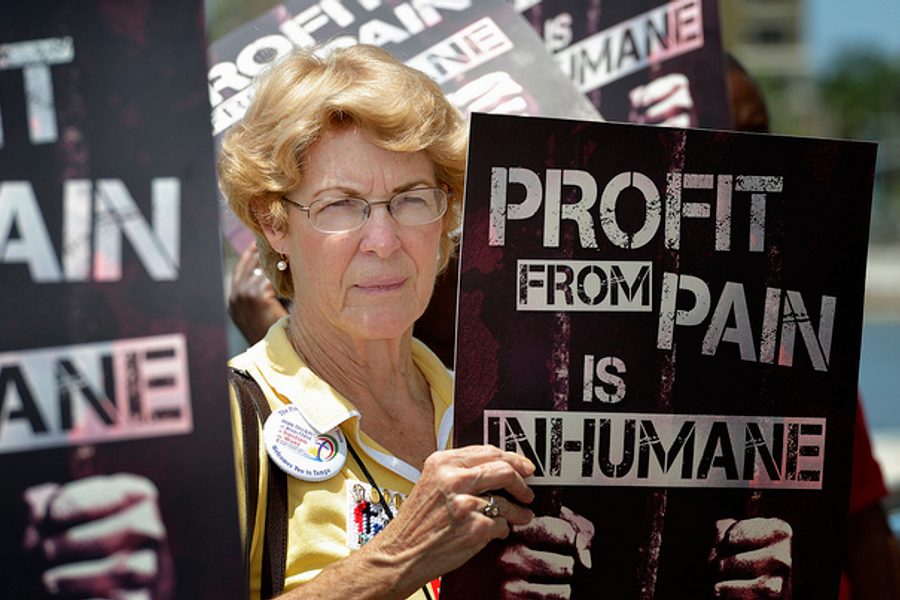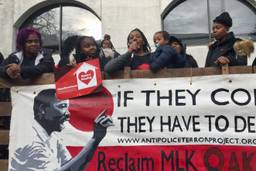The U.S. Is Ending the Use of Federal Private Prisons—But That Won’t End Mass Incarceration
The news is a welcome reminder that marching in the streets can lead to reforms down the road.
Julia Clark-Riddell

In a major victory for the criminal justice reform movement, the Department of Justice released plans today to end its use of private prisons over the next five years, according to a memo obtained by The Washington Post.
The memo, from Deputy Attorney General Sally Yates, states that the department plans on not renewing contracts with private prison operators or substantially scaling down those contracts, with the ultimate goal of abolishing federal private prisons altogether.
Yates also wrote that private prisons “do not provide the same level of correctional services,” “do not save substantially on costs” and “do not maintain the same level of safety and security.”
There are currently over 22,000 prisoners — about 11 percent of the total federal prison population — in 13 federally contracted private prisons around the nation. The memo does not detail where the prisoners will be moved, but Yates told the Post that by May 1, 2017, the total federal private prison population will fall to less than 14,200 inmates.
The 13 federal private prisons are operated by three corporations: the Corrections Corporation of America, The GEO Group, Inc. and Management & Training Corporation. According to Yates, all of the contracts with these corporations will be up within the next five years.
The DOJ announcement follows years of protests, petitions and divestment movements both through coalitions of immigrant and labor groups and on college campuses.
Organizers against private prisons note that the for-profit institutions increase recidivism (and are incentivized to do so, as they can make over $3,000 profit per year per prisoner) and often force prisoners to work for free. The private prisons also have more incidents of contraband, lockdowns, inmate discipline, telephone monitoring and grievances per capita than public prisons, according to a review by the Office of the Inspector General of the DOJ. Contract prisons have higher rates of assaults, both by inmates on prison guards and inmates on each other, than public prisons. In 2012, one GEO Group private juvenile prison in Florida closed after a judge called it “a cesspool of unconstitutional and inhuman acts and conditions.”
Some universities, such as Columbia University in June 2015 and the University of California system in December 2015, heeded the warnings of student activists who organized awareness weeks, orchestrated extended sit-ins and passed student government resolutions, and divested substantially from private prisons. Other universities, such as Northwestern University in Chicago, ignored their student activists and spoke of fiduciary responsibilities and profit margins.
In what may prove to be quite the “I-told-you-so” moment for divestment activists, stocks for the corporations have already begun plummeting. On Thursday morning, stocks for the Corrections Corporation of America dropped 38.02 percent in the first four hours after the announcement and stocks for the GEO Group dropped 39.19 percent.
The fight against private prisons ranged beyond the college campus, stretching across many aspects of the progressive movement. The National Prison Divestment Campaign hosted protest marches in New York and met with Congressional staffers in Washington, D.C. The ACLU has organized protests and released damning reports of abuses within private facilities. Earlier this year, progressive outlets such as Mother Jones and The Nation published exposés and in-depth investigations on the cruelties of the private prison industry, finding that prisoners with serious illnesses are often denied healthcare to save the bottom line, which has led to the premature death of at least two private prison inmates. When the Movement for Black Lives released their platform earlier this month, they demanded federal action “against G4S and other global private prison companies that are profiting from the shackling of our community in the US, in Palestine, in Brazil and around the world.” Even Bernie Sanders introduced a bill in 2015 to end for-profit prisons.
However, while this development is a step in the right direction for the United States’ broken criminal justice system, it is by no means a panacea. Most significantly, the majority of prisoners are held in public prisons, which are often home to similar abuses and are more than capable of perpetuating the social ills of mass incarceration even without their private counterparts. The DOJ memo makes no mention of closing public prisons or attempting to diminish the total prison population.
The DOJ memo also fails to abolish the private detention centers scattered around the U.S.-Mexico border and throughout the country, operated by corporations such as G4S and Geo Group through contracts from the Department of Homeland Security. These detention centers hold tens of thousands of people, including thousands of children, who are denied the due process of law and held in inhumane conditions.
Additionally, state private prisons remain untouched by the DOJ’s policy. There are over 100,000 inmates in state private prisons, almost five times more than those in federal private prisons, according to 2014 statistics from the Bureau of Justice Statistics.
Finally, the private prison industry has a powerful lobby, and could feasibly reverse the DOJ’s plans. Even after Hillary Clinton announced that she wanted to “end private prisons and private detention centers,” Damon Hininger, the CEO of Corrections Corporation of America, said his company would be “just fine.”
“I would say that being around 30 years and being in operation in many, many states, and also doing work with the federal government going back to the 1980s, where you had Clinton White House, you had a Bush White House, you had Obama White House, we’ve done very, very well,” Hininger said, while speaking at a REITWeek investor forum in June.
Still, up until 2013, the inmate population at private prisons had been rapidly increasing, up by almost 800 percent since 1980, with no end in sight. The closure of 13 federal private prisons is the most significant reversal of that tide to date and serves as a welcome reminder that marching in the streets can lead to reforms down the road.





